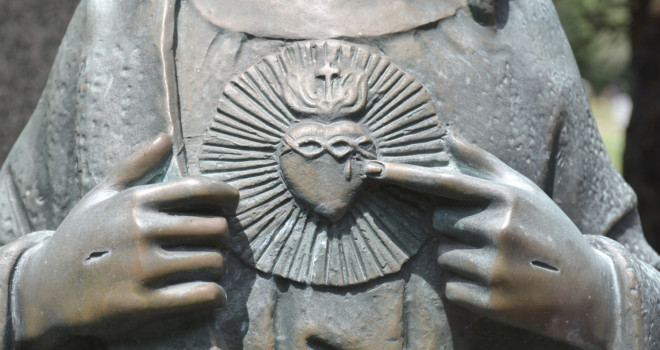We are approaching the Solemnities of Corpus Christi and the Sacred Heart of Jesus in the Church’s liturgical calendar. These feast days offer to us a special time and space to reflect on, pray about, and grow in the most important aspects of the Catholic life and devotion. Hopefully, in these days and by this reflection, all of us will develop deeper devotion to the Eucharist and the Sacred Heart of Jesus, and become better disciples of the Lord in the process.
In my book, A Life of Conversion: Meeting Christ in the Gospels, I identify conversion as the hallmark of the Christian life. Conversion is the thing that must take place in the minds and hearts of each and every Christian, each and every day. Without answering Jesus’ call to conversion (see Mark 1:15), we are not living the essence of Christianity and discipleship.
Since conversion is necessary in the Christian life, we need to know what it is. The Catechism of the Catholic Church provides us with a concise and helpful definition of conversion: “A radical reorientation of the whole life away from sin and evil, and toward God.” With just a little reflection, it is quite easy to see how this definition brings us into close proximity to the Sacred Heart of Jesus. In such close proximity, we are able to understand more fully why we should take up this blessed devotion.
The word “radical” implies that something is happening at the very root of our lives and souls (radix is the Latin word for root). The heart, according to Jewish spirituality, is the very center of one’s self. It is the place from whence all personal qualities and decisions emanate. Thus, to be radically reoriented means that one’s heart is transformed, even replaced. Of course, this causes me to think of the well-known passage from the prophet Ezekiel: “A new heart I will give you…and I will take out of your flesh the heart of stone and give you a heart of flesh” (36:26). The new heart that the Lord wishes to give us, the heart to which we must be conformed, is none other than the Sacred Heart of Jesus.
The next word, “reorientation,” is also important. Reorientation means that something has gone astray and it must be recalibrated. Indeed, since the original sin, all of us have gone astray, and we need recalibration. But recalibration toward what? The Sacred Heart of Jesus is the only heart has always chosen and completed the will of the Heavenly Father in perfect charity. Remember, it was Jesus who prayed, “Father…not my will, but thine, be done” (Lk. 22:42).
Then there is the phrase “of the whole life.” Christianity is not a partial proposition. It is all or nothing. So, conversion must be whole and total. When my whole life is converted, each of my faculties is transformed. My body, mind, and soul are changed. It is my heart that makes all the difference in such change. I can know something needs to happen, but not do it (think of Paul’s exclamation in Romans 7). Not until my heart is convinced will I be truly be transformed. Thus, I should look to the perfect heart, the Heart that always loves fully and perfectly.
The last phrase of the definition is also important and instructive. Conversion must be “away from sin and evil, and toward God.” This seems quite obvious, but we really can never hear or read this enough on our Christian journey. Sin and evil are real and we must do all that we can to avoid those realities. In fact, a great horror of sin is the very first disposition that one needs to develop a devotion to the Sacred Heart of Jesus. Beyond that, we know from the Bible that the Son of God receives the name Jesus because “he will save his people from their sins” (Mt. 1:21). Turning away from sin is what allows us to be in full communion with the God who is infinitely perfect.
So, on one hand, we can conclude that conversion leads us to the Sacred Heart of Jesus. On the other hand, we also can see that a devotion to the Sacred Heart of Jesus is a wide and certain path to ongoing, lifelong conversion. Connecting more deeply to Jesus’ heart each and every day will cause our own hearts to turn from sin and selfishness, becoming more like His.
There are several practical things that we can do to grow in our devotion to the Sacred Heart of Jesus and to be converted more fully toward His mercy. One of the simplest practices is enthronement of the image of the Sacred Heart of Jesus in our homes and/or places of work. We are physical beings. We have senses. The more we see the reality for which we strive, the more we are likely to take the actions necessary to reach that end. In this case, if we see the Sacred Heart of Jesus frequently, we will consciously make the choice to turn our hearts to receive and spread His great love and mercy.
Following the enthronement of the image of the Sacred Heart of Jesus, we can grow in devotion by making frequent, even daily, consecration to His Heart. One of the most common and popular versions of this consecration was written by St. Margaret Mary Alacoque, the seventeenth-century French nun who received the devotion to the Sacred Heart of Jesus from the Lord, and shared it with as many people as she could. Another excellent version of the consecration is the one penned by Pope Leo XIII, given to the Church along with his encyclical letter on devotion to the Sacred Heart, Annum Sacrum.
Perhaps the most common prayer associated with this devotion is the Litany to the Sacred Heart of Jesus. In that prayer, we identify the heart of Jesus as the source of all blessings and strength that we desire in our lives. And, we recall that it was the heart of Jesus that was pierced and broken for our sins. Thus, we beg for God’s mercy through the benevolent heart of Jesus, over and over again.
Beyond the prayers of consecration, there are some classic spiritual texts that we can take up in prayerful reading. One of the most well-known texts is The Autobiography of Saint Margaret Mary Alacoque. It is the story of the saint’s growth in the devotion and her efforts to purvey it as widely as possible. In this tiny book, the humble nun leads us right to the heart of Jesus and to the essence of divine love. Another helpful text is Devotion to the Sacred Heart of Jesus, by Fr. John Croiset, SJ. It was originally published in 1691, just after St. Margaret Mary’s death, and it tells us more than any other about the motives and means of growing in this devotion. It also contains numerous prayers for practicing the devotion on many occasions. Finally, there is Annum Sacrum, the encyclical letter from Pope Leo XIII, which I referenced above. Pope Leo XIII was a prolific author and, more importantly, a great spiritual leader. He held this devotion in high esteem for himself and for the whole Church. Reading any of these texts and practicing the devotions that they prescribe will allow our hearts to be converted more fully to Jesus and His Sacred Heart.
During our lives here on earth, we must seek to be more fully in union with the heart of Jesus so that, at the end of life, we may enjoy the beatific vision with Him. Thus, we need to be in a constant state of conversion and we need to be constantly conformed to divine love. Emulating the Sacred Heart of Jesus will allow us to be converted and fulfill the goal that our Lord has for our lives. Each of us can begin, or begin anew, this powerful devotion as these two special feast days arrive.
✠













